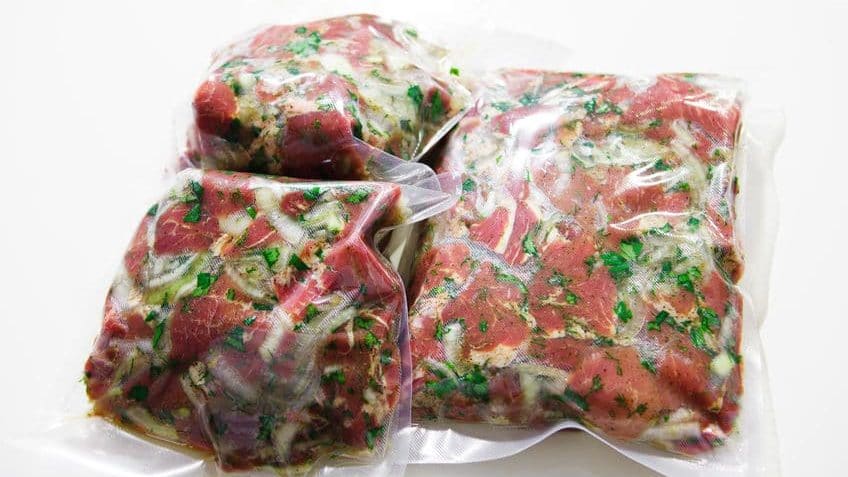In this article we will cover how to properly marinate a steak to add some taste complexity and to take your grilling experience to the next level. Steak doesn’t need much help to taste amazing. A dash of salt is enough for most people. However, master grillers know that a good marinade never hurts. Steak meat is not very dense so it absorbs most flavors. A good marinade can make a cheap steak taste great and an expensive cut taste even better! There are a few secrets to marinate a steak, we will be going over some in this article. Along with including a few of my favorite marinade recipes. Remember that cooking is about self-exploration, get out there and test things for yourself. It’s a great way to learn, it also helps build confidence. Plus nothing beats a great meal that you came up with yourself. Before we get started with marinades let’s go over certain cuts of beef, and how to prepare them for their marinade.
The Meats
The majority of the meat you are going to be able to buy are pre-butchered. If you are one of the lucky few with a butchers shop nearby, you may be able to get some special cuts or non-butchered meats. Two cuts, in particular, are ready for the marinade instantly. These cuts are the strip steak and filet mignon. These cuts are considered the two best steak cuts. They are naturally tender and contain a good amount of marbled fat. But let’s be honest, those cuts are expensive. Most of the time I buy cheaper cuts that require more work. I’d rather save money than time. These “cheaper” cuts really excel by using a marinade. Cuts such as the hanger steak and skirt steak really need a marinade. The tougher cuts should be tenderized prior to marination. I like to use a pin based tenderizer to allow the marinade to better penetrate the meat. But a hammer based one works just as well. Once the meat is ready for the marinade we move onto the next step.
The Marinade
Marinades vary greatly depending on personal tastes. First, let’s differentiate between a brine and a marinade. A brine is a salt water mixture. Majority of brines are just water and salt, some include other seasonings. A marinade, on the other hand, can contain a wide range of ingredients. From soy sauce to beer, anything can be a marinade. Marinades and brines will always have some overlap. Most marinades call for both water and salt. The difference is a brine limits the ingredients whereas a marinade welcomes them. On top of making a marinade, timing is also important. The marinade needs time to really get into the meat. It also needs a cool environment, the fridge, to stay fresh. The timing comes down the two things, did you tenderize the meat and the size of the cut. If the cut is huge it will take more time to marinate. Meat that’s been tenderized will take a shorter time to marinate. The recommended timing is no less than 30 minutes in the marinade. Personally, I suggest a few hours to really let the flavors mix. Another important aspect is the object used to marinate. I use large zip lock bags, they allow me to remove any air ensuring the contact of the meat to the marinade. A lot of people use large bowls, another good option. You need to make sure that the meat is completely submerged. You can use another bowl or some plastic wrap to keep it under the surface of the marinade. Whatever you use to marinate is fine as long as the meat is completely submerged in the marinade. Now onto the fun part, mixing the marinade!
Making a Marinade
Most marinades are easy, some are not. Depending on the flavor you want you can literally marinate in anything. A popular marinade is just beer! Even though beer makes a simple yet strong marinade, you can find very complex recipes, some may be overwhelming. Marinades can be as simple as one ingredient or as complex as 20. Don’t get bogged down in the details. Remember it’s safe to explore combinations of ingredients on your own. Who knows you might come up with a new favorite everyone loves! Depending on the basis of your marinade, watery or oily, the outcome differs. An oily marinade will provide more a “coating” on the meats. Leading to a better char and crunch. It will also cause more severe flare-ups. Using an oil-heavy marinade may require you to space out the cuts more so than you normally would. The intense flare-ups can become overwhelming if the meat is to close together.
Hot Tip!
Oil heavy marinades have a stronger flavor.
To go over mixing I will include a few different methods. Each one leads to a slightly different outcome.
By Hand Method
Mixing a marinade by hand may require a little oil. The oil will have trouble mixing with certain liquids. You can try adding an emulsifier. Common emulsifiers are agar-agar, xanthan gum, mustard, and honey. Combine the ingredients in a large container, bowl, large pan, a leak proof bag. If you need to emulsify any oil do so after adding all other ingredients. Using a whisk or spoon mix the ingredients together, until thoroughly combined. This method may require a lot of work, depending on the ingredients you use. Physical work may not be what you want to do, there are plenty of other options.
The Blender Method
The blender, if you have one, is a great tool for marinades. My personal blender/Immersion blender method is great for oil-based marinades. In the blender I combine a lot of soy sauce with some water, some rice vinegar, a spoon or two of red miso, and just a splash of fish sauce. A few quick bursts and the ingredients are somewhat combined. For this particular recipe I want some miso chunks for now. I then put it on a low speed and start slowly pouring in oil. The process of incorporating oil into a mixture slowly will create a stronger bond. Not to mention may stop splashbacks. Whichever method you choose you are going to have success. Marinades are very easy, they only have the illusion of difficulty. The beauty of marinades has been displayed above. The importance of measurements does not really exist. Yes, if you go overboard with an ingredient it might not taste great, but that’s why we taste what we make! If you are following a guide, follow the recipe. If not use your taste buds, they can not lie. There are a few other methods, including the one ingredient method, such as beer or wine. Different beers will provide different flavors. Dark beers like Stouts and Porters make interesting marinades. The most important thing in making a marinade is to explore flavors you may never have before. Like the example I gave above, when have you last had a steak with red miso? Explore flavors you like, see what goes well together.
Using a Marinade
Using the marinade is simple. Depending on the device you are using results may vary. I’ve found that zip lock bags are the best option. They allow you to completely submerge the meat, massage it into the meat, and is super easy to clean up. If you have a food vacuum sealer you can vacuum out all the air and really make sure that all the meat in contact with the marinade.
If you don’t want to have such an impact on the environment you can use a large bowl. When I use a bowl I like to use some plastic to push the meat under the surface of the water. By ensuring the plastic is airtight will securely submerge your meats. Whichever vessel you use to marinate one thing is vital, complete submersion. Some parts of the meat may come out over time, but for the most part you want 100% coverage for the entire marination process. A personal step I like is to massage the marinade into the meat a bit. If you are using a bag this step is easy, just massage through the bag. If you are using a bowl, this step is very messy, I suggest gloves. You are going to need to massage the meat itself. The last step in the marination process is timing. Depending on the thickness of your marinade timing varies. You can find a wide range of times on google, ranging from thirty minutes to days. I find that if you have time, 2-3 hours in the magic number. After three hours I find no difference in taste. If you’re pressed for time, thirty minutes can do the trick. Flavor may not be super strong if you are using a lighter or non-oil based marinade. Oil marinades coat the surface, whereas water ones will penetrate the surface. Over time oil based marinades will do the same. If you can’t spare thirty minutes tenderize your meat and use an oil-based marinade. Massage it in and allow to sit for as long as you can.
Cooking a Marinade
Depending on your marinade you may need to break some of your usual cooking rules. A steak usually doesn’t get flipped a lot. Depending on what’s in your marinade, the coating may burn. You may be required to flip it more often to keep the marinade coating from burning. Another aspect for danger is in flare-ups. If your marinade is very oily the flare-ups may become very strong. The oil will drip down to the flame, along with animal fat. Always be safe, if you are using a lot of oil be sure to space out the meats on the grill.
Great Marinades
Some really good marinade recipes are below. Remember that these are just examples, feel free to change them to your tastes.
- Combine soy sauce, olive oil, and garlic powder. Once fully mixed slowly mix in your favorite hot sauce. Pour over your steaks let sit for at least one hour.
- Combine water and salt until it tastes like the ocean. Add ground pepper, garlic powder, rosemary and vegetable oil. Place the steaks in the mix, or pour over. Let sit for at least one hour.
- Combine canola oil, and chipotle peppers. Using a blender helps, start with the peppers blending into a paste. Slowly mix in the oil until thoroughly combined. Add salt, smoked paprika and chopped garlic. Pour over steaks and massage in for best results. Let sit for at least one hour. Best results if left overnight. This marinade has a tendency to be spicy!
- Combine soy sauce, water, and ginger. (You may use oil) The ginger may not fully incorporate, don’t stress. Let the meat sit for at least 8 hours to really get the ginger flavor into the meats. You can substitute soy sauce by just making a brine and adding minced ginger.
You can see a lot of common ingredients from my examples. Oil marinades are my personal favorite. If allowed to sit and penetrate the meat they lead to juicy steaks, even at well done. Keep pushing yourself, explore new flavors. Keep cooking interesting. You will have more fun, and end up with new delicious foods. Hopefully this article about how to properly marinate a steak has encouraged you to go out and try something new in grilling!




